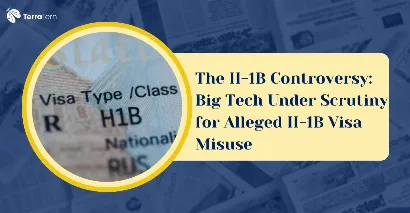Key Highlights
Positioning itself at the heart of the convoluted and rather controversial U.S. immigration and employment policy, the H-1B visa programme has been playing a major role in readmitting highly skilled foreign professionals into the American pool of highly skilled workers. This has, however, taken on a rude light following a report that has accused some of the most famous names in the tech industry of having manipulated the very regulations meant to guide this programme. Allegations that have emerged and been reported by Newsweek, and further brought to light by an article by The Economic Times, could be described as directing job applicants to a systematic method of recruiting them into specialised teams referred to as immigration or global mobility teams, which entail bypassing normal recruitment practice. It has sparked a new argument about the authenticity of the H-1B system and its effect on the United States labour markets, especially for the graduates of America.
Also Read: H-1B Visa: Explore Your Options for A Job Switch In The US
Unpacking the Allegations: A Deeper Look into Recruitment Practices
At the heart of the controversy lies a hiring practice that critics argue contributes to the development of a parallel hiring pipeline that is discriminatory. Rather than posting their resumes with human resources departments or through such publicly available job listing sites, the job postings are allegedly directing job applicants to special immigration teams. Such a devious shift in strategy is claimed to have one objective only: to privilege H-1B visa holders and applicants, thus relegating qualified American workers outside this particular talent pool. Using the practice is perceived as a disguised yet effective means of manipulating the system so that companies can continue to employ foreigners in these positions, but not break any H-1B regulations.
The H-1B visa, known as a speciality occupation visa, which is used only in the technology sector and necessitates an expertise that would require theoretical or technical knowledge, is an essential part of the economy of the United States. Proponents make the point that it was necessary to fill much-needed skills shortages that cannot be met through domestic supply. The opponents have, however, always argued that firms use the program to depress wages and pay foreign employees who are equally skilled to their American counterparts.
This new set of accusations gives us a concrete example of how such rules could be twisted. Even the knowledge of this parallel system of recruitment is an opaque process, with Jobs. Now, a site devoted to getting Americans jobs on the H-B list is telling Newsweek how little the US workforce knows of its existence.
Also Read: H-1B Cap Reached for FY 2026: What’s Next for Applicants?
The Impact on the Domestic Workforce
With the economic times unstable and the rates of unemployment increasing, especially as it concerns fresh college graduates, these allegations are of special concern. The idea that American graduates are losing out on the chances as jobs are closed to them in America is strong and evocative. Perhaps considered to be the shining epitome of innovation and opportunity, the technology industry is now under scrutiny for its ability to give back where it soars its profits most of all to one product: labour. The accusations also invoke concerns about whether the premise behind the H-1B visa programme, which is to supplement, rather than supplant, the U.S. workforce, is being met.
A Conduit Between Enhancement and Chance
The H-1B visa has traditionally provided a means through which international students have come to make the arduous passage from American universities to full-time employment. Most of these students have been learning in the U.S. for years, have developed enormous debt in the form of student loans, and have been part of the academic and social life of the country. To them, the H-1B visa is the fitting point of culmination to their efforts and an opportunity to contribute to the U.S. economy. The accusations, nonetheless, make this story more complicated.
Although the visa permits proper inroads to work, the purported abuse by corporations may end up unintentionally tainting the whole programme and creating an atmosphere hostile to the law-abiding. It brings about a conflict between the objectives of international talent attraction and the safeguarding of domestic work.
Also Read: US Visitor Visa B1/B2
Political and Economic Ramifications: A Contentious Debate
The H-1B program is not merely a policy to immigrate people into the United States but a hotbed within American politics. On the one hand, the advocates of tech bosses and corporate patrons found that the visa is key to having a competitive advantage in an ever-globalised world. They argue that in the absence of the best and brightest worldwide, American innovation would begin to crumble, and firms would be compelled to outsource abroad. They also focus on the fact that the visa holders tend to have unique skills and perspectives, and they are essential to the completion of complicated, multinational projects.
The opponents (labour advocates and opponents of immigration reforms), on the other hand, claim that the programme depresses wages of American workers, thus displacing US jobs. They cite the relatively low wages paid to H-1B visa holders as compared to their American counterparts doing the same jobs, thus making businesses have a financial reason to hire foreign workers. All these claims concerning the bent rules and discriminatory hiring rules only add fuel to this fire and offer practical illustrations of the things that were being debated in Washington for so long.
The H-1B visa has a political discourse around it, with calls to reform the visa being major; some administrations have promised to put the interests of American workers first. This near-constant political bickering underscores the strong ideological rifts between the different ideologies regarding the place of immigration within the U.S. economy.
Conclusion
The claims made by big tech firms against bending H-1B regulations present a critical lesson on how complex the United States immigration system has become and how susceptible it is. Although the H-1B visa programme aims to bring foreign talent and cover genuine shortages of skills, its misuse casts huge doubts over the corporate ethical conduct and safety of the local people. The scandal highlights the importance of maintaining more clarity and applying the law on immigration more accurately, implying fairness to all job seekers irrespective of their country.
The way to proceed will be fraught with a separate balance of policies that will advance innovative agendas but also protect the interests of the American workers. The question will probably continue to be one of the contentious issues of the future years, as it will define immigration policy and the fate of the American working force. Visit TerraTern to know more!








